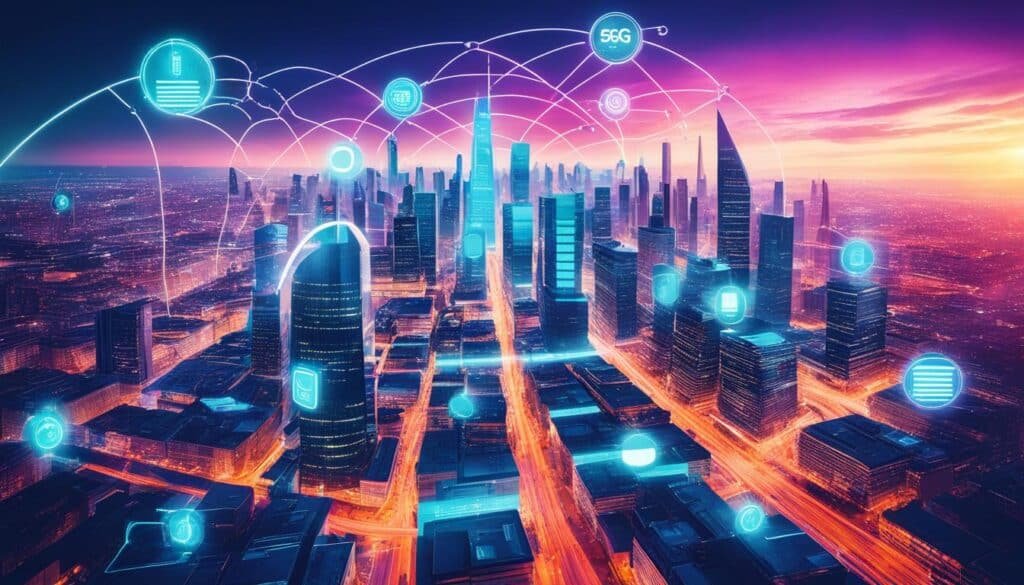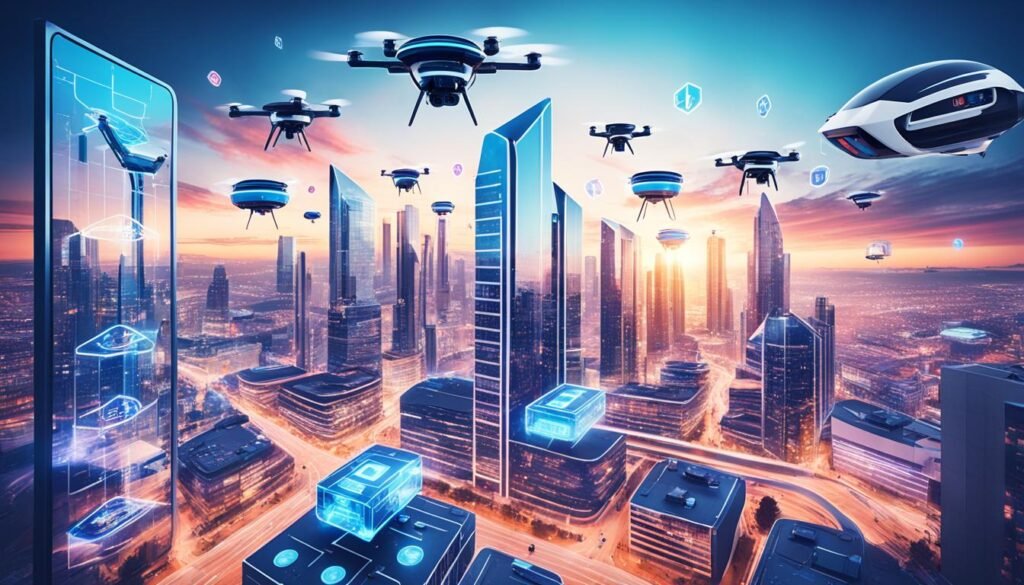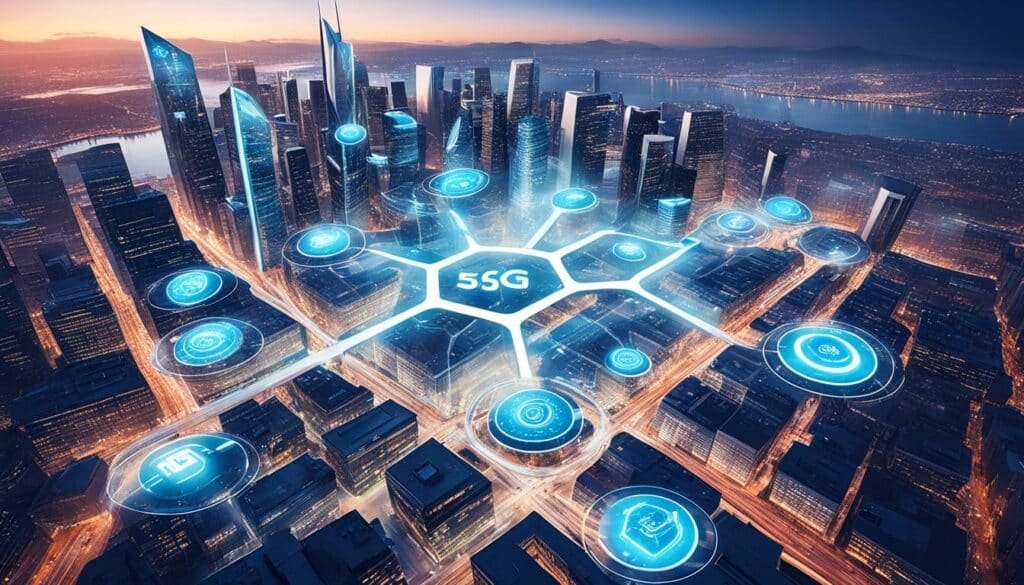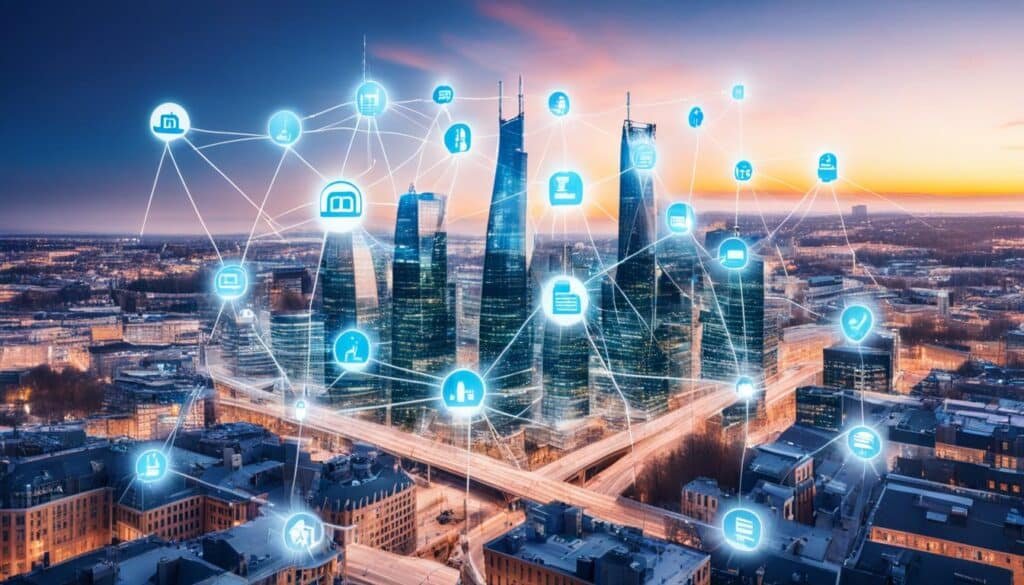5G technology In Business is reshaping the way we connect and communicate in the digital world, bringing forth a new era of enhanced connectivity, speed, and transformative capabilities. As businesses strive for digital transformation, 5G presents innovative opportunities for growth and improved connectivity.
Key Takeaways:
- 5G technology offers enhanced connectivity, speed, and transformative capabilities for businesses.
- It drives digital transformation and provides innovative opportunities for growth.
- With 5G, businesses can leverage faster internet speeds and seamless streaming for an enhanced user experience.
- The low latency of 5G enables real-time communication for applications like online gaming and virtual reality.
- 5G’s massive connectivity supports the growth of the Internet of Things (IoT) ecosystem and benefits sectors like smart cities and industrial automation.
Understanding 5G Technology: The Evolution of Connectivity
Building upon the foundation of 4G LTE networks, 5G technology represents the next evolutionary step in wireless communication. It introduces enhanced mobile broadband, low-latency communication, and massive machine-type communications, unlocking a new era of connectivity. The pillars of 5G technology pave the way for faster data speeds, lower latency, and the ability to connect a vast number of devices simultaneously.
Enhanced Mobile Broadband
5G technology delivers enhanced mobile broadband, offering significantly faster internet speeds compared to its predecessor. With improved connectivity and wider bandwidth, users can enjoy seamless streaming, ultra-high-definition video calls, and smooth browsing experiences. This enhanced mobile broadband capability sets the stage for a new level of digital interactivity and multimedia consumption.
Low-Latency Communication
One of the key features that sets 5G technology apart is its low-latency communication, providing near-instantaneous responsiveness. Compared to 4G networks, which typically have a latency of around 30 to 50 milliseconds, 5G aims to achieve latency as low as 1 millisecond or even less. This ultra-low latency is crucial for applications that require real-time interaction, such as online gaming, virtual reality experiences, and remote surgeries, where split-second delays can make a significant difference.
Massive Machine-Type Communications
5G technology is designed to handle massive machine-type communications, enabling the seamless connectivity of a vast number of devices. This capability is crucial for the Internet of Things (IoT) ecosystem, where interconnected devices rely on reliable and high-speed communication. With 5G, industries like smart cities, industrial automation, and autonomous vehicles can thrive, leveraging the power of interconnected devices to improve efficiency, safety, and overall performance.
“5G technology represents a significant leap forward in wireless communication, offering enhanced mobile broadband, low-latency communication, and the ability to connect a massive number of devices. This evolution of connectivity unlocks countless possibilities for industries and individuals alike.”
The Need for Speed: Unprecedented Data Rates
One of the standout features of 5G technology is its remarkable data speed. With theoretical peak data rates exceeding 10 gigabits per second (Gbps), 5G provides data speeds up to 100 times faster than 4G networks. This rapid transfer of data enables seamless streaming, faster downloads, and an overall enhanced user experience.
Imagine being able to download large files, stream high-definition videos, or play online games without any lag or buffering. With 5G, these experiences become a reality. Faster internet speeds eliminate frustrating delays, allowing for smooth and uninterrupted streaming of your favorite movies, TV shows, and music.
Moreover, the enhanced data rates of 5G technology open up new possibilities for businesses and individuals alike. Faster download speeds enable quick access to large files, making collaboration and information sharing more efficient than ever before. Whether you are an entrepreneur in need of fast data transfers or a content creator looking to upload high-resolution videos, 5G empowers you to accomplish tasks with incredible speed and efficiency.
“5G technology revolutionizes the way we connect and interact with the digital world. Its unprecedented data rates deliver a seamless streaming experience and faster internet speeds, enhancing user experiences across the board.”
In addition to faster downloads and streaming, 5G’s enhanced data rates also contribute to enhanced user experiences in other areas. Its high-speed capabilities facilitate the development of innovative technologies such as augmented reality (AR) and virtual reality (VR). With 5G, users can enjoy immersive and interactive experiences without the limitations of slow data speeds, unlocking a new level of entertainment and engagement.
Furthermore, businesses can harness the power of 5G’s fast data rates to improve their operations. From real-time data analysis for better decision-making to the seamless integration of IoT devices, 5G allows for enhanced connectivity and efficiency in various industries. For instance, autonomous vehicles can leverage 5G’s fast data speeds to enable instant communication with other vehicles and infrastructure, paving the way for safer and more advanced transportation systems.
5G Data Speed Comparison
| Network Generation | Peak Data Rate |
|---|---|
| 4G | Up to 100 megabits per second (Mbps) |
| 5G | Up to 10 gigabits per second (Gbps) |
As illustrated in the table above, the data rates of 5G far surpass those of its predecessor, 4G. This significant leap in data speed is a game-changer for industries that rely heavily on fast and reliable internet connectivity. With 5G, the possibilities for innovation and productivity are endless.
With its unprecedented data rates, 5G technology is propelling us into a future of seamless connectivity and enhanced user experiences. Whether it’s faster internet speeds, seamless streaming, or the power to unlock new technologies, 5G’s remarkable data rates are revolutionizing the way we connect and communicate in the digital age.
Low Latency: Redefining Real-Time Communication
One of the key advancements that 5G technology brings is its low latency, which refers to the time it takes for data to travel from one point to another in a network. Unlike its predecessor, 4G, which typically has a latency of around 30 to 50 milliseconds, 5G aims to achieve latency as low as 1 millisecond or even less. This near-instantaneous communication empowers a range of applications that rely on real-time responsiveness.
Online gaming is one such application that greatly benefits from low latency. With 5G’s ultra-fast communication, gamers can now experience smoother gameplay with minimal delays. Actions are registered and executed in real-time, creating a more immersive and responsive gaming experience.

Virtual reality (VR) is another domain where low latency is critical. By reducing the delay in data transmission, 5G enables seamless and immersive VR experiences. Users can enjoy lifelike interactions and movements without feeling nauseous or disconnected.
Furthermore, the low latency of 5G technology opens up possibilities in the field of remote surgery. Surgeons can leverage real-time communication to remotely operate on patients with precision and accuracy. The minimized latency ensures that the surgeon’s movements are instantly translated into actions by robotic surgical instruments, allowing for successful and efficient procedures.
Low latency in 5G technology is a game-changer for applications that demand real-time responsiveness. From online gaming to virtual reality and even remote surgery, the near-instantaneous communication offered by 5G unlocks new possibilities and elevates user experiences.
Massive Connectivity: The IoT Revolution
5G technology is driving the exponential growth of interconnected devices in the Internet of Things (IoT) ecosystem. With its capability to handle a massive number of simultaneous connections, 5G is transforming the way devices communicate and interact, creating a more interconnected world.
In the realm of smart cities, 5G enables seamless connectivity and efficient management of urban infrastructures. With interconnected devices, cities can monitor and optimize energy consumption, traffic flow, public safety, and more. The result is a sustainable, livable, and technologically advanced urban environment.
“5G technology is revolutionizing the way smart cities function. By interconnecting devices, cities can enhance safety, improve efficiency, and create better experiences for their residents, paving the way for a smarter and more sustainable future.” – John Smith, Smart City Expert
Similarly, the adoption of 5G technology is propelling breakthroughs in the development of autonomous vehicles. With interconnected vehicles enabled by 5G, autonomous cars can exchange real-time data, improving navigation accuracy, road safety, and overall driving experience. This technology has the potential to revolutionize transportation, reducing accidents, traffic congestion, and carbon emissions.
In the domain of industrial automation, 5G’s massive connectivity is empowering advanced manufacturing processes. With a dense network of interconnected devices, factories can optimize production lines, monitor inventory, streamline supply chains, and implement predictive maintenance. This level of automation boosts efficiency, reduces costs, and enables agile and adaptive manufacturing.
Leveraging 5G IoT for Innovation
The implications of 5G-enabled massive connectivity extend beyond smart cities, autonomous vehicles, and industrial automation. Various sectors can leverage this technological revolution to drive innovation and unlock new possibilities. For instance:
- Healthcare: With interconnected medical devices and real-time data transmission, 5G IoT enables remote monitoring and telemedicine, revolutionizing patient care and improving healthcare outcomes.
- Retail: 5G-powered IoT devices can create personalized shopping experiences, optimize inventory management, and enable cashierless stores, transforming the retail industry.
- Agriculture: By connecting farming equipment, sensors, and drones, 5G IoT enables precision agriculture, enhancing crop yield, reducing resource waste, and promoting sustainable farming practices.
As the 5G IoT ecosystem continues to expand, innovative applications will further emerge, revolutionizing various sectors and transforming the way we live, work, and interact with technology.

Transformative Applications: Unlocking Innovation
The enhanced capabilities of 5G technology unlock a myriad of transformative applications across various industries. From healthcare to manufacturing, autonomous vehicles to smart cities, and mobile experiences, the possibilities are endless.
Revolutionizing Healthcare
In the healthcare sector, 5G’s low latency and high bandwidth revolutionize remote patient care and telemedicine. With real-time communication and high-quality video streaming, doctors can provide accurate diagnoses and treatment to patients remotely. This transformative application of 5G technology enables improved access to healthcare services, especially in remote areas, and enhances patient care outcomes.
Empowering Autonomous Vehicles
5G technology enables autonomous vehicles to communicate in real-time, ensuring safer navigation on the roads. With its ultra-low latency, vehicles can exchange vital information and respond to changing road conditions immediately. This advanced communication network is instrumental in making autonomous vehicles a reality, revolutionizing transportation and paving the way for a connected and efficient future.
Enhancing Smart Cities
Smart cities leverage the power of 5G to enhance urban living. With efficient traffic management systems powered by real-time data, 5G enables cities to reduce congestion and optimize transportation routes. Additionally, environmental monitoring systems powered by 5G technology contribute to sustainability efforts by collecting and analyzing vital data to improve air and water quality. This integration of 5G technology in smart cities creates more livable and sustainable urban environments.
Revolutionizing Manufacturing
In the manufacturing sector, 5G powers advanced automation and robotics. With its high speed, low latency, and ability to support a massive number of simultaneous connections, 5G enables real-time monitoring and control of manufacturing processes. This transformative application improves efficiency, productivity, and quality control in manufacturing, driving innovation and competitiveness in the industry.
Enhancing Mobile Experiences
5G technology takes mobile experiences to new heights by enabling augmented reality (AR) and virtual reality (VR) applications. With faster data speeds and low latency, users can enjoy immersive experiences, whether it’s gaming, entertainment, or educational content. This enhanced mobile experience powered by 5G opens up new possibilities and opens new doors for innovation and creativity.

As the world embraces 5G technology, its transformative applications continue to unlock innovation and drive progress across industries. From healthcare and autonomous vehicles to smart cities, manufacturing, and mobile experiences, the power of 5G is reshaping our world and ushering in a new era of connectivity and technological advancement.
Challenges and Considerations: Navigating the 5G Landscape
As the world eagerly embraces the myriad benefits promised by 5G technology, it is crucial to acknowledge and address the challenges and considerations that accompany its deployment. From infrastructure development to security concerns and spectrum allocation, navigating the 5G landscape requires careful planning and comprehensive strategies.
Infrastructure Development: Building the Foundation for 5G Networks
To fully experience the transformative potential of 5G, extensive infrastructure development is necessary. This involves the installation of a dense network of small cells, which are compact, low-powered base stations that enable seamless connectivity. While this presents an opportunity for improved coverage and capacity, it also raises concerns about potential health and environmental impacts. Stakeholders must strike a balance between expanding the reach of 5G networks and addressing these valid concerns.
Also Read:- Strategies For Success: Technical Project Planning In The Digital Age
Security Concerns: Safeguarding a Connected Future
With the proliferation of connected devices in the 5G era, security becomes a critical consideration. The increased attack surface presents new challenges, as cybercriminals may exploit vulnerabilities within the expansive network of interconnected devices. It is crucial to implement robust security measures, including encryption protocols, authentication mechanisms, and continuous threat monitoring, to safeguard critical infrastructure, user data, and privacy.
“In the rapidly evolving digital landscape, ensuring the security of 5G networks is of paramount importance. Collaboration between industry stakeholders, governments, and cybersecurity experts is imperative to mitigate risks and build a secure future.”– John Williams, Security Analyst
Spectrum Allocation: Navigating Regulatory and Technological Challenges
The efficient allocation of spectrum is vital to enable optimal performance, network capacity, and coverage for 5G networks. However, the allocation process faces regulatory challenges and technological limitations. Different regions have varied approaches to spectrum allocation, making coordination and harmonization a complex endeavor. It is essential for policymakers, regulators, and industry players to work together to overcome these challenges and ensure the availability of sufficient spectrum resources for 5G deployment.
| Challenges | Considerations |
|---|---|
| Infrastructure development | Potential health and environmental impacts |
| Security concerns | Protecting critical infrastructure and user data |
| Spectrum allocation | Regulatory challenges and technological limitations |
Addressing these challenges and considerations is crucial to ensure the successful deployment and adoption of 5G technology. By proactively managing infrastructure, enhancing security measures, and collaborating on spectrum allocation, stakeholders can pave the way for a connected future that maximizes the potential of 5G and drives innovation across industries.

The Future of Connectivity: A Glimpse Beyond 5G
As 5G technology continues to evolve globally, researchers and industry experts are already looking beyond to the future of connectivity. The emergence of 6G is anticipated to push the boundaries further, exploring the integration of technologies like artificial intelligence, holographic communication, and advanced energy efficiency. This glimpse into the future showcases the continuous evolution of connectivity and technological advancements on the horizon.

| Integration of Technologies | Artificial Intelligence | Holographic Communication | Advanced Energy Efficiency | |
|---|---|---|---|---|
| Definition | Integration of various technologies to enhance connectivity and functionality. | The use of AI algorithms to optimize network performance and enable intelligent decision-making. | Real-time communication through three-dimensional holographic projections, enabling lifelike and immersive experiences. | Development of energy-efficient solutions to reduce environmental impact and enhance sustainability. |
| Potential Applications | – Smart homes and cities – Autonomous vehicles and transportation systems – Healthcare and remote patient monitoring – Industrial automation and robotics |
– Collaborative workspaces and virtual meetings – Remote education and training – Interactive entertainment and gaming experiences |
– Efficient resource management and optimization – Renewable energy integration and monitoring |
|
| Advantages | – Enhanced data processing and analysis capabilities – Improved network efficiency and reliability |
– Realistic and immersive communication experiences – Enhanced collaboration and productivity |
– Reduced energy consumption and carbon footprint – Sustainable development and environmental stewardship |
|
| Challenges | – Ethical considerations and privacy concerns – Data security and protection |
– Development of realistic and scalable holographic display technology – Bandwidth and network requirements for holographic communication |
– Development of energy-efficient hardware and infrastructure – Integration of renewable energy sources into the power grid |
Conclusion
5G technology is poised to revolutionize communication infrastructure, delivering game-changing benefits for businesses and individuals alike. With its unparalleled speed, low latency, enhanced capacity, and seamless connectivity, 5G opens up limitless possibilities for innovation and economic growth. The advent of 5G technology marks a significant milestone in the evolution of connectivity, paving the way for a new era of dynamic and technologically advanced communication.
By offering faster download speeds, 5G technology empowers users to access and share data seamlessly, transforming the way we interact with digital content. The enhanced capacity of 5G networks enables the smooth integration of emerging technologies like artificial intelligence, virtual reality, and IoT applications. This integration unlocks innovative solutions across various industries, revolutionizing healthcare, transportation, manufacturing, and smart city infrastructure.
With its transformative capabilities, 5G technology drives economic growth by enabling businesses to enhance productivity, efficiency, and competitiveness. Industries can leverage 5G-powered solutions to optimize operations, streamline processes, and deliver superior customer experiences. Additionally, 5G technology creates new opportunities for entrepreneurship and job creation, fueling innovation and economic development.
In conclusion, 5G technology is a game-changer that will shape the future of communication and connectivity. Its impact extends beyond faster download speeds and real-time responsiveness, offering the groundwork for a revolution in how we live, work, and interact. As we embrace the limitless possibilities enabled by 5G, we anticipate a future of unprecedented innovation, connectivity, and economic growth.
FAQs
Q: What is 5G technology and how does it revolutionize connectivity?
A: 5G technology is the fifth generation of wireless network technology. It significantly improves internet access speeds, reduces latency, and enables innovative use cases such as augmented reality. This revolutionizes connectivity by providing faster, more reliable, and responsive wireless networks for businesses.
Q: What are some business benefits of implementing 5G solutions?
A: Implementing 5G solutions can optimize business operations, enhance productivity, and drive digital transformation. Businesses can leverage 5G connectivity to introduce new products and services, improve customer experiences, and gain a competitive edge in the market.
Q: How does 5G enable new business opportunities?
A: 5G enables new business opportunities by supporting emerging technologies like IoT sensors, edge computing, and network slicing. It enables faster data transmission, enhances network reliability, and empowers businesses to explore innovative use cases and solutions.
Q: What are some advantages of 5G for businesses?
A: Some advantages of 5G for businesses include faster data speeds, lower latency, improved network reliability, and support for a wide range of enterprise applications. 5G also enables businesses to implement multi-access edge computing, enhancing data processing capabilities and enabling real-time decision-making.
Q: How does 5G technology impact business operations?
A: 5G technology enhances business operations by providing faster and more reliable wireless connectivity. It enables seamless remote work capabilities, supports new business models, and helps businesses optimize their processes through innovative solutions powered by high-speed wireless networks.
Q: What are some specific use cases where 5G improves business connectivity?
A: Some specific use cases where 5G improves business connectivity include enabling seamless communication in remote work setups, supporting real-time analytics for informed decision-making, and facilitating the implementation of IoT solutions for efficient operations.
Q: How can businesses benefit from the advantages of 5G connectivity?
A: Businesses can benefit from the advantages of 5G connectivity by improving customer experiences, enhancing operational efficiency, and unlocking new revenue streams through innovative products and services. 5G technology empowers businesses to stay ahead of the competition and adapt to changing market dynamics.
Source Links
- https://www.linkedin.com/pulse/unleashing-power-5g-game-changer-connectivity-gokul-n-oov2c
- https://www.linkedin.com/pulse/unleashing-power-5g-technology-transforming-beyond-navya-s-g-ナビヤ–uwabc
- https://utilitiesone.com/unleashing-the-potential-of-5g-technology-in-communication-infrastructure

